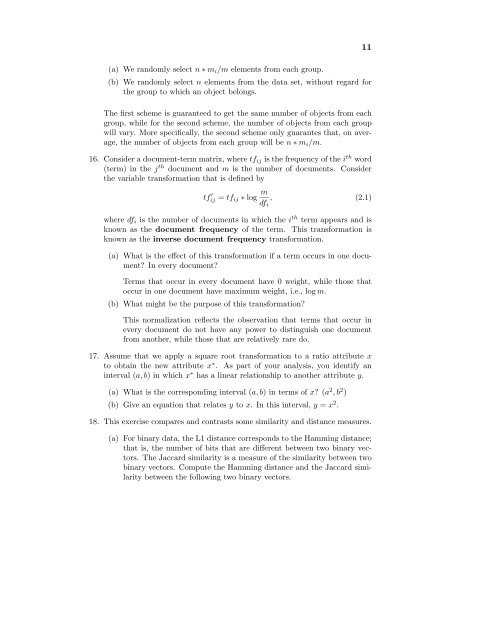Introduction To Data Mining Instructor's Solution Manual
Introduction To Data Mining Instructor's Solution Manual
Introduction To Data Mining Instructor's Solution Manual
You also want an ePaper? Increase the reach of your titles
YUMPU automatically turns print PDFs into web optimized ePapers that Google loves.
11<br />
(a) We randomly select n ∗ mi/m elements from each group.<br />
(b) We randomly select n elements from the data set, without regard for<br />
the group to which an object belongs.<br />
The first scheme is guaranteed to get the same number of objects from each<br />
group, while for the second scheme, the number of objects from each group<br />
will vary. More specifically, the second scheme only guarantes that, on average,<br />
the number of objects from each group will be n ∗ mi/m.<br />
16. Consider a document-term matrix, where tfij is the frequency of the i th word<br />
(term) in the j th document and m is the number of documents. Consider<br />
the variable transformation that is defined by<br />
tf ′ ij = tfij ∗ log m<br />
, (2.1)<br />
dfi<br />
where dfi is the number of documents in which the ith term appears and is<br />
known as the document frequency of the term. This transformation is<br />
known as the inverse document frequency transformation.<br />
(a) What is the effect of this transformation if a term occurs in one document?<br />
In every document?<br />
Terms that occur in every document have 0 weight, while those that<br />
occur in one document have maximum weight, i.e., log m.<br />
(b) What might be the purpose of this transformation?<br />
This normalization reflects the observation that terms that occur in<br />
every document do not have any power to distinguish one document<br />
from another, while those that are relatively rare do.<br />
17. Assume that we apply a square root transformation to a ratio attribute x<br />
to obtain the new attribute x ∗ . As part of your analysis, you identify an<br />
interval (a, b) inwhichx ∗ has a linear relationship to another attribute y.<br />
(a) What is the corresponding interval (a, b) in terms of x? (a2 ,b2 )<br />
(b) Give an equation that relates y to x. In this interval, y = x2 .<br />
18. This exercise compares and contrasts some similarity and distance measures.<br />
(a) For binary data, the L1 distance corresponds to the Hamming distance;<br />
that is, the number of bits that are different between two binary vectors.<br />
The Jaccard similarity is a measure of the similarity between two<br />
binary vectors. Compute the Hamming distance and the Jaccard similarity<br />
between the following two binary vectors.


